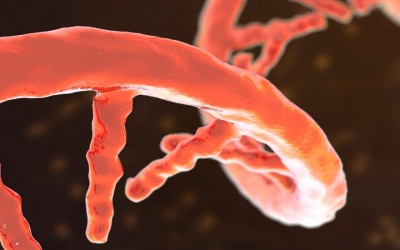
Findings about Asthma, Stroke, and a Possible Therapy
Filtering the Factors
A new therapy may be developed for very preterm preeclampsia patients, if the results of a small pilot study are confirmed in a larger trial. Researchers have been looking for a safe way to prolong pregnancy by at least the 48 hours needed to allow steroid shots to mature fetal lungs. (Each safe extra day in utero eliminates two or three days in NICU, and means higher survival rates for many of the babies affected by preeclampsia.)
In 2003 a paper published by Dr. Ananth Karumanchi in the Journal of Clinical Investigation presented evidence that a protein named soluble fms-like tyrosine kinase (sFlt-1) caused many of the symptoms in preeclampsia. Karumanchi studied the placentas from preeclamptic pregnancies and found that they were producing far more sFlt-1 than the placentas from normal pregnancies. The protein binds to another protein and this compromises the repair of blood vessels, leading to many of the symptoms such as hypertension and proteinuria as damage to the maternal bloodstream accumulates when normal repair stops. Since then, dozens of studies have confirmed the role of sFlt-1 in preeclampsia, although as with all scientific research there are likely to be further interesting developments.
A paper published in Circulation reports on a small pilot study by Drs Karumanchi and Ravi Thadhani that seeks to filter out excess sFlt-1, thus prolonging the pregnancy. Initially the treatment was only offered once, so that researchers could confirm that it did not worsen matters. After confirming that it did drop sFlt-1 blood levels without any obvious complications, the trial looked at the effect of multiple treatments. In the three women with very preterm preeclampsia where this therapy was attempted more than once, delivery was delayed by two or three weeks before delivery became necessary.
However, since this therapy won't help the placenta implant any better in the first phase of pregnancy, this approach won't eliminate the disease. And since sFlt-1 is only one of the proteins implicated in the development of the disease, women and babies will still suffer some preeclampsia symptoms even if this protein is removed from maternal circulation. However, this targets some of the symptoms that make delivery most urgent. This approach appears to be supported by the basic research and current understanding of this condition and is promising, although very preliminary. A much larger trial will need to be conducted to confirm these results and to confirm the safety of this strategy.
Asthma Increases Risk for Preeclampsia
This month the British Journal of Obstetrics and Gynaecology published a meta-analysis of many smaller studies which reported a correlation between poorly-controlled asthma and preeclampsia. Women with poorly-controlled asthma were at 1.5 times the normal (roughly 5%) risk of developing preeclampsia. This means that many women with bad asthma symptoms had normal pregnancies, and that many women with no asthma developed preeclampsia, but more women with poorly-controlled asthma developed preeclampsia than would have been expected.
In a normal pregnancy, the placenta is able to establish what's known as "maternal tolerance" - the mother's immune system tolerates the foreign placenta and doesn't try to reject it. When this tolerance is established, it often affects other immune conditions (like asthma) as well, and the symptoms of those conditions will improve during pregnancy. So when symptoms actually worsen instead of improving, it can be a warning that maternal tolerance hasn't been properly established, which can alert the pregnant woman and her care providers that she is more likely to develop preeclampsia.
If your asthma symptoms worsen in pregnancy, please do mention this study and the worsened symptoms immediately to your care providers and follow up as they recommend.
Research has shown that preeclampsia is associated with increased risk of early life childhood asthma in children less than 3 years old over and above that associated with maternal asthma alone.
Stroke on the Rise
The CDC reported that their hospital data show a substantial rise in the number of pregnancy-related strokes between 1994-1995 and 2006-2007. This rise correlates almost exactly to the rise in rates of hypertension and obesity in the population of pregnant women over that timeframe. The increase translates to an increase from 15 to 22 strokes per 100,000 pregnant women. Preeclampsia is the most likely explanation for this dramatic rate increase of 47%. Women with a history of hypertension or obesity can improve their chance of a safe pregnancy outcome by working closely with their care providers to watch for preeclampsia symptoms and treating the condition in a timely fashion if it does arise.
Related Articles

Comparative effectiveness of prophylactic strategies for preeclampsia: a network meta-analysis of randomized controlled trials Finding strategies for preventing preeclampsia is a top priority in...

Masked Pregnancy-Associated Hypertension as a Predictor of Adverse Outcomes Pregnant women who have risk factors for preeclampsia may be advised by their health care provider to monitor their...

Preeclampsia Prevention by Timed Birth at Term In this study, researchers looked at different ways to find out if a pregnant woman might get preeclampsia at term (>37 weeks) and when would be...

Polygenic prediction of preeclampsia and gestational hypertension All humans have near-identical DNA sequences across the estimated 6 billion-letter code that makes up the human genome. However, slig...

Noninvasive preeclampsia prediction using plasma cell-free RNA signatures. Messenger ribonucleic acid (mRNA) is a molecule that contains the instructions to tell cells how to make proteins. mRNA is m...
